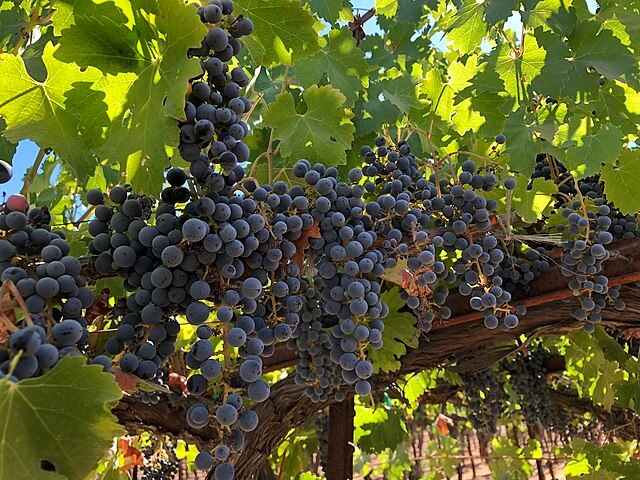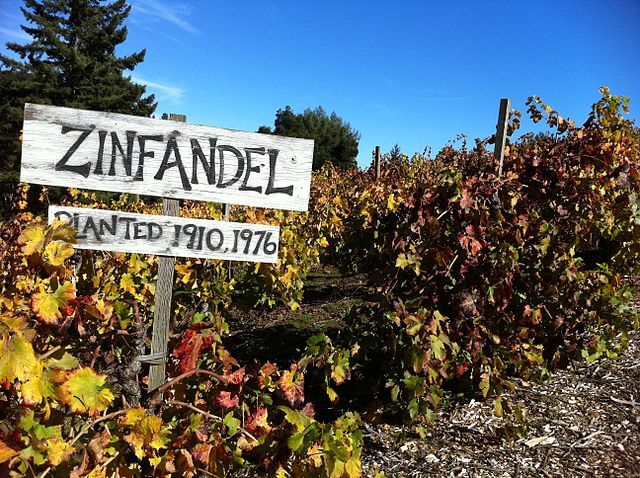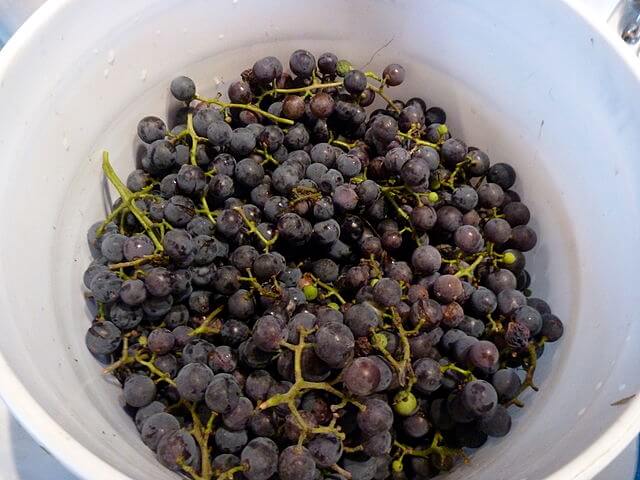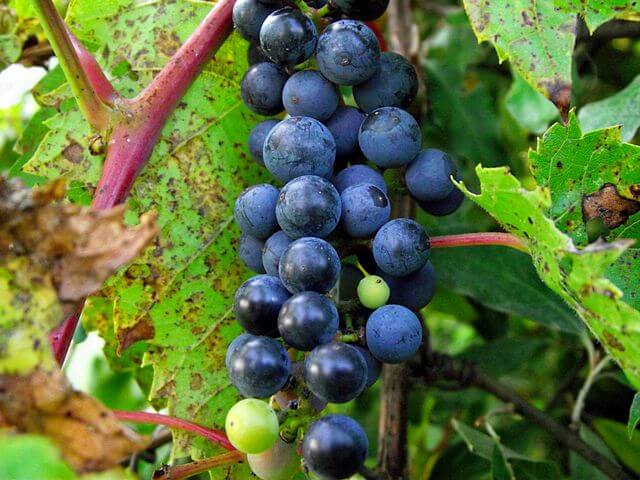Grapes are incredibly well known as a widely cultivated fruit. Grown in vineyards and harvested to make delicious wines and juices; and also eaten by the bunch as ‘table grapes’, in seedless or even unique cotton candy-flavored varieties! But what about their wild counterparts? How are they different from supermarket and vineyard grapes? And importantly, are wild grapes edible?
Belonging to the Vitis genus, there are almost 80 species of grape found throughout the world. And around 25 of them are wild native species, indigenous to North America. Currently, it’s believed there are a staggering 10,000+ grape cultivars throughout the world. Each cultivated to create a unique set of characteristics.

How Are Wild Grapes Different To Cultivated Grapes?
The grapes that are grown in vineyards, and that we buy in supermarkets today, are a domesticated variety of wild grape species. Much like the native crab apples, we may find in the wild, there are also wild grape species across the World too.
The History
The wild grape species V. vinifera subsp. sylvestris (or sometimes just Vitis sylvestris), is considered to be the ancestor of the most famous cultivated grape varieties today which are known as Vitis vinifera. Varieties such as Sauvignon Blanc, Pinot Grigio, Zinfandel, and Chardonnay are processed and produced into incredibly popular wines.

This species originated in Eurasia and is native to the Mediterranean and parts of central Asia. It has been cultivated for centuries and hybridized into an amazing variety of grape cultivars. Vineyard owners in particular will mix and match species to create unique hybrids, which then create unique wine and juice flavorings.
The Characteristics
Usually, wild grape species have much smaller fruits than their cultivated counterparts. Grapes are farmed and grown for their sweetness, whether that’s as a table grape or wine grape. So these domesticated varieties tend to be sweeter, and also larger, to create a better product and maximize the amount that can be harvested. The plants themselves are very similar, with both wild and cultivated grapes having vines, tendrils, and similar leaves.
Can You Eat Wild Grapes?
Yes! All species of wild grape found throughout the world are perfectly edible. Straight off the vine, some wild native grapes may have quite a tart taste, whereas others are sweeter.
What Can Wild Grapes Be Used For?
Wild grapes can be used to create all the familiar products that cultivated grapes are used for. From wine to raisins! However, different characteristics will make some species better suited to different uses. For example, the Fox Grape (Vitis labrusca), indigenous to eastern North America, has a sweet and earthy ‘musk’ flavor. This has made it a popular parent plant to many American wine cultivars, such as Niagra and Concord.

Some native American grape species are very popular rootstock for other European species as they often have high resistance to certain diseases, soils, or climate. The American Riverbank Grape (Vitis riparia) is often a popular rootstock choice.
Other wild grape species are better suited to creating jams, jellies, raisins, vinegars, and even grape seed oils. The concord grape variety (from the Fox Grape species) is particularly popular for creating jelly. Especially for the classic peanut butter and jelly sandwich!

Finding and Foraging Wild Grapes
So, wild grapes are tasty, and a great ingredient! But where can we find them? The majority of wild native grapes in the US are found in the eastern states, like the ‘Riverbank’ or ‘Frost’ Grape (Vitis riparia), found in the northeastern states. To the Winter Grape (Vitis vulpina), which is found across most of the eastern states, from New York to Florida.

Look for them along riverbanks, rocky stream edges, or climbing trees at the edge of woodland. They thrive best in moist soils with a lot of sunshine.
Grapevines are usually quite easy to identify. They’re climbing plants, with narrow vines, which soon become woody with age. In the fall, the green leaves blush with shades of orange and red. However, the most easily identifiable characteristics are the clusters of small, deep purple berries which develop and ripen from late summer to early fall.
Cautions to consider when foraging wild grapes in America
There is a lookalike that wild grapes can sometimes be mistaken for. Common moonseed (Menispermum canadense) is particularly toxic and can be fatal if the fruits or leaves are eaten. At first glance, the plants, particularly the fruit, may seem similar. They’re both vine plants, with clusters of deep purple berries. But with close inspection, you should easily be able to tell them apart.
For quick identification, you can cut open one of the berries and check the seeds. Look out for the tell-tale crescent, or moon-shaped, seeds within the moonseed berries. They’re native to the eastern states too, particularly along stream edges or damp woodland areas, so take care when foraging.

Take care to avoid other clustered berry species like porcelain berries (Ampelopsis brevipedunculata) and even pokeweed (Phytolacca americana). As with foraging any berry, make sure you can identify with 100% certainty before eating.
A Tasty Wild Edible
Wild grapes are a fantastic fruit to forage and discover in the wild. Whether you try your hand at creating your own wild grape wine. Or try growing a native species in your own backyard to cover an archway or wall. They’re a beautiful and versatile plant species!
—————Written by Hannah Sweet
Hannah is a freelance writer and graphic designer from the UK. With a penchant for travelling, photography and all things botanical, she enjoys writing about a wealth of topics and issues, from conservation and slow living, to design and travel. Learn more about her writing and design services at www.sweetmeanders.co
Many of our readers find that subscribing to Eat The Planet is the best way to make sure they don't miss any of our valuable information about wild edibles.
See our privacy policy for more information about ads on this site







6 Responses
I’ve had wild grapes grow on one side of my house. I ate them for as long as they grew there. Personally, they made my lips itchy but I never had any other side effects or even indigestion.
The wild varieties do tend to be much more astringent. I have found this with certain other forageable plants such as ornamental pears and certain crabapples.
Aren’t moonseed grapes poisonous?
To be clear poison moonseed is a completely different plant from grapes. the scientific name of moonseed is menispermum canadense. The scientific name of the genus that grapes are in is vitis. They can look superficially similar but there are some identifying characteristics.
i have wild grapes strawbeerys rasberrys and maulberrys growning where i live and man every summer i go out and just eat them im still a teen so i love it
That’s awesome.. One time I found some paw paws growing, and I didn’t know what they were at the time. After I found out I just pigged out haha.